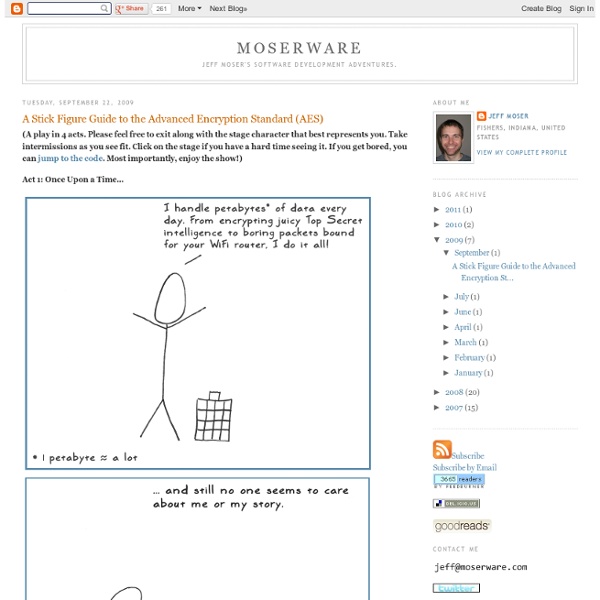A Stick Figure Guide to the Advanced Encryption Standard (AES)
(A play in 4 acts. Please feel free to exit along with the stage character that best represents you. Take intermissions as you see fit. Click on the stage if you have a hard time seeing it. If you get bored, you can jump to the code. Most importantly, enjoy the show!) Act 1: Once Upon a Time... Act 2: Crypto Basics Act 3: Details Act 4: Math! Epilogue I created a heavily-commented AES/Rijndael implementation to go along with this post and put it on GitHub. The Design of Rijndael is the book on the subject, written by the Rijndael creators. Please leave a comment if you notice something that can be better explained. Update #1: Several scenes were updated to fix some errors mentioned in the comments.Update #2: By request, I've created a slide show presentation of this play in both PowerPoint and PDF formats.
Ethiopian multiplication
Ethiopian multiplication You are encouraged to solve this task according to the task description, using any language you may know. A method of multiplying integers using only addition, doubling, and halving. Method: Take two numbers to be multiplied and write them down at the top of two columns. For example: 17 × 34 Halving the first column: Doubling the second column: Strike-out rows whose first cell is even: Sum the remaining numbers in the right-hand column: So 17 multiplied by 34, by the Ethiopian method is 578. The task is to define three named functions/methods/procedures/subroutines: one to halve an integer, one to double an integer, and one to state if an integer is even. Use these functions to create a function that does Ethiopian multiplication. References [edit] ACL2 [edit] ActionScript Output: ex. 17 348 68 Strike4 136 Strike2 272 Strike1 544 Keep= 578 [edit] Ada package Ethiopian is function Multiply(Left, Right : Integer) return Integer;end Ethiopian; [edit] Aime [edit] ALGOL 68 Output:
Binary Game
Skip to Content | Skip to Footer Cisco Binary Game The Cisco Binary Game is the best way to learn and practice the binary number system. It is great for classes, students and teachers in science, math, digital electronics, computers, programming, logic and networking. It is also a LOT of fun to play for anyone who likes to play fast-paced arcade games.
Low Level Bit Hacks You Absolutely Must Know
I decided to write an article about a thing that is second nature to embedded systems programmers - low level bit hacks. Bit hacks are ingenious little programming tricks that manipulate integers in a smart and efficient manner. Instead of performing some operation (such as counting the 1 bits in an integer) by looping over individual bits, these programming nuggets do the same with one or two carefully chosen bitwise operations. To get things going I'll assume that you know what the two's complement binary representation of an integer is and also that you know all the the bitwise operations. I'll use the following notation for bitwise operations in the article: & - bitwise and | - bitwise or ^ - bitwise xor ~ - bitwise not << - bitwise shift left >> - bitwise shift right The numbers in the article are 8 bit signed integers (though the operations work on arbitrary length signed integers) that are represented as two's complement and they are usually named 'x'. Here we go. Bit Hack #1. 1. 2.
Bit Twiddling Hacks
By Sean Eron Anderson seander@cs.stanford.edu Individually, the code snippets here are in the public domain (unless otherwise noted) — feel free to use them however you please. The aggregate collection and descriptions are © 1997-2005 Sean Eron Anderson. Contents About the operation counting methodology When totaling the number of operations for algorithms here, any C operator is counted as one operation. Compute the sign of an integer int v; // we want to find the sign of v int sign; // the result goes here // CHAR_BIT is the number of bits per byte (normally 8). sign = -(v < 0); // if v < 0 then -1, else 0. // or, to avoid branching on CPUs with flag registers (IA32): sign = -(int)((unsigned int)((int)v) >> (sizeof(int) * CHAR_BIT - 1)); // or, for one less instruction (but not portable): sign = v >> (sizeof(int) * CHAR_BIT - 1); The last expression above evaluates to sign = v >> 31 for 32-bit integers. Alternatively, if you prefer the result be either -1 or +1, then use: sign = (v !
turing
university lectures computer science
Whether your goal is to earn a promotion, graduate at the top of your class, or just accelerate your life, lectures can help get you there. Our archives of lectures cover a huge range of topics and have all been handpicked and carefully designed by experienced instructors throughout the world who are dedicated to helping you take the next step toward meeting your career goals. Lifelong learns can turn their free time turn into self-improvement time. The online lectures on this list are more than lecture notes or a slideshow on a topic -- they were designed for audiences like you, with carefully sequenced themes and topics taught by veteran educators, and often with additional resources for your own independent study. Lecture courses are a valid and vital learning tool, and may be one of the best methods of learning available.
Related:
Related:



